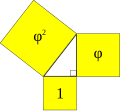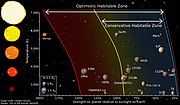Kepler-67 is a star in the open cluster NGC 6811 in the constellation Cygnus. It has slightly less mass than the Sun and has one confirmed planet, slightly...
4 KB (274 words) - 04:03, 30 April 2024
Johannes Kepler (/ˈkɛplər/; German: [joˈhanəs ˈkɛplɐ, -nɛs -] ; 27 December 1571 – 15 November 1630) was a German astronomer, mathematician, astrologer...
102 KB (12,601 words) - 04:57, 12 July 2024
zone: Kepler-560b, Kepler-705b, Kepler-1229b, Kepler-1410b, Kepler-1455b, Kepler-1544 b, Kepler-1593b, Kepler-1606b, and Kepler-1638b. The Kepler team...
172 KB (16,217 words) - 18:48, 3 August 2024
List of multiplanetary systems (redirect from Kepler-55)
with the most confirmed planets are the Sun (the Solar System's star) and Kepler-90, with 8 confirmed planets each, followed by TRAPPIST-1 with 7 planets...
260 KB (8,680 words) - 08:00, 29 July 2024
List of stars in Cygnus (redirect from Kepler-533)
Dennis; Zhou, Yixiao; White, Timothy R. (2020), "Asteroseismology of 36 Kepler subgiants – I. Oscillation frequencies, linewidths, and amplitudes", Monthly...
64 KB (298 words) - 19:17, 8 August 2024
the open cluster NGC 6811 contains two known planetary systems, Kepler-66 and Kepler-67. Additionally, several hot Jupiters are known to exist in the Beehive...
51 KB (6,261 words) - 23:07, 28 July 2024
mechanics, Kepler's equation relates various geometric properties of the orbit of a body subject to a central force. It was derived by Johannes Kepler in 1609...
24 KB (3,575 words) - 16:59, 9 August 2024
Kepler-22 is a Sun-like star in the northern constellation of Cygnus, the swan, that is orbited by a planet found to be unequivocally within the star's...
10 KB (659 words) - 10:59, 9 May 2024
Kepler-90, also designated 2MASS J18574403+4918185, is a F-type star located about 2,790 light-years (855 pc) from Earth in the constellation of Draco...
19 KB (1,757 words) - 13:46, 19 March 2024
proven a false positive by NASA in 2015. Several other KOIs, like Kepler-577b and Kepler-1649b, were considered potentially habitable prior to confirmation...
57 KB (3,062 words) - 07:31, 11 August 2024
Kepler-1649c is an Earth-sized exoplanet, likely rocky, orbiting within the habitable zone of the red dwarf star Kepler-1649, the outermost planet of...
10 KB (885 words) - 21:09, 14 January 2024
exoplanetary signatures found in light curves of two sdBV stars observed by Kepler", Astronomy & Astrophysics, 627: A86, arXiv:1906.03321, Bibcode:2019A&A...
50 KB (2,828 words) - 05:36, 9 August 2024
Kepler-39b (formerly known as KOI-423b), is a confirmed extrasolar object (either a Jovian planet or brown dwarf because of its mass) discovered orbiting...
8 KB (937 words) - 03:07, 22 December 2023
Kepler-452 is a G-type main-sequence star located about 1,810 light-years away from Earth in the Cygnus constellation. Although similar in temperature...
13 KB (1,189 words) - 08:01, 9 May 2024
Kepler-186 is a main-sequence M1-type dwarf star, located 177.5 parsecs (579 light years) away in the constellation of Cygnus. The star is slightly cooler...
17 KB (1,539 words) - 04:15, 18 July 2024
The open cluster NGC 6811 contains two known planetary systems Kepler-66 and Kepler-67. The Ages of Stars, David R. Soderblom, 31 Mar 2010 Towards asteroseismically...
28 KB (3,508 words) - 08:34, 1 June 2024
Kepler-138, also known as KOI-314, is a red dwarf located in the constellation Lyra, 219 light years from Earth. It is located within the field of vision...
21 KB (2,009 words) - 02:53, 13 February 2024
A Kepler triangle is a special right triangle with edge lengths in geometric progression. The ratio of the progression is φ {\displaystyle {\sqrt {\varphi...
18 KB (2,031 words) - 19:48, 11 June 2024
Kepler College (formerly Kepler College of Astrological Arts and Sciences) is an online certificate program for the study of astrology . Based out of...
6 KB (570 words) - 13:05, 29 September 2023
November 2013. Kepler-88b is the innermost planet in the system and is Neptune-sized but almost half as massive. Kepler 88c is about 67% as massive as...
6 KB (517 words) - 18:20, 19 February 2024
(2011). "Modeling Kepler transit light curves as false positives: Rejection of blend scenarios for Kepler-9, and validation of Kepler-9d, a super-Earth-size...
38 KB (3,892 words) - 17:07, 17 May 2024
two planets announced are designated Kepler-47b, and Kepler-47c, and the third, later discovery is Kepler-47d. Kepler-47 is the first circumbinary multi-planet...
22 KB (2,132 words) - 06:23, 22 December 2023
This is a partial list of exoplanets discovered by the Kepler space telescope, running from star number 1 through 500, inclusive. All lists: 1–500 501–1000...
170 KB (2,916 words) - 06:55, 29 June 2024
Kepler-11, also designated as 2MASS J19482762+4154328, is a Sun-like star slightly larger than the Sun in the constellation Cygnus, located some 2,110...
18 KB (1,536 words) - 04:13, 18 July 2024
This is a partial list of exoplanets discovered by the Kepler space telescope, running from star number 501 through 1000, inclusive. All lists: 1–500...
59 KB (53 words) - 21:03, 9 February 2024
Kepler-1708b (previously known as KIC 7906827.01) is a Jupiter-sized exoplanet orbiting the Sun-like star Kepler-1708, located in the constellation of...
13 KB (1,198 words) - 17:45, 28 June 2024
Kepler-80, also known as KOI-500, is a red dwarf star of the spectral type M0V. This stellar classification places Kepler-80 among the very common, cool...
14 KB (1,316 words) - 14:52, 16 June 2024
the habitable zone of Kepler-62, by the Kepler team was announced on April 19, 2013. The planets, named Kepler-62e and Kepler-62f, are likely solid planets...
134 KB (13,722 words) - 05:53, 12 July 2024
bodies belonging to the habitable zone of yellow dwarfs, such as Kepler-22b, Kepler-452b or Earth, take hundreds of days to complete an orbit around their...
35 KB (3,485 words) - 23:02, 3 May 2024
Kepler-1649b is a Venus-like exoplanet orbiting Kepler-1649. Kepler-1649 is a type-M red dwarf star estimated to be roughly ¼ the radius of the Sun with...
2 KB (144 words) - 20:12, 24 May 2024

















